Quiver Quantitative - The U.S. economy grew at a modest pace of 1.6% in the first quarter, as reported by the Commerce Department, a rate that fell short of the anticipated 2.4% growth expected by economists. This deceleration reflects a broader slowdown from the more robust growth rates seen last year, suggesting an economy grappling with several headwinds. Notably, the report highlighted a persistent challenge: inflation remains higher than expected, which dampens the likelihood of the Federal Reserve easing interest rates in the near future. This persistent inflation has led to a sharp rise in yields on the 10-year Treasury note (TLT) and contributed to significant losses in the stock market, with the Dow Jones Industrial Average experiencing a substantial drop.
Despite the overall economic slowdown, consumer spending remains strong, supported by continuous hiring and wage growth over the past years. The resilience of consumer spending is evident in sectors like healthcare and insurance, which saw increased expenditure. However, a shift in spending patterns—from goods to services—and variations in business inventories and international trade dynamics weighed on the economy's overall growth last quarter. This shift is seen by some economists as a positive sign, potentially paving the way for increased investment in the coming quarters.
Market Overview: -U.S. GDP growth slows to 1.6% in Q1, missing analyst expectations. -Inflation gauge exceeds forecasts, raising concerns about price pressures. -Investors react negatively, triggering bond selloff and stock market decline.
Key Points: -GDP growth falls short of expectations at 1.6%, indicating a slowdown. -Personal consumption expenditures price index rises 3.7%, exceeding forecasts. -Bond yields surge on inflation worries, with 10-year Treasury surpassing 4.7%. -Dow Jones Industrial Average (DIA) drops over 600 points amid market turmoil. -Consumer spending remains robust, particularly in healthcare and services. -Businesses like GM (GM), Lockheed Martin (NYSE:LMT) (LMT), and Nucor (NYSE:NUE) (NUE) show resilience in investment. -Slowdown in goods spending and volatile inventories weigh on Q1 growth. -Low-income consumers and housing market face headwinds from inflation.
Looking Ahead: -Fed policy response to inflation remains central to the economic outlook. -Consumer spending strength is a key factor to monitor in coming quarters. -Potential for a loosening labor market could eventually slow inflation.
Inflation continues to be a significant concern, with the Fed's preferred gauge indicating that core personal consumption expenditures (PCE) rose by 3.7% annually in the first quarter, exceeding the 3.4% forecast. This uptick suggests that inflation pressures remain robust, complicating the Fed's policy decisions. The ongoing high inflation rates, coupled with strong economic data, suggest that the U.S. economy might not be cooling as quickly as hoped, which could delay any monetary easing by the Fed.
Looking forward, while the U.S. economy shows signs of resilience, the persistent inflation poses challenges for both policymakers and the public. The economic outlook remains mixed as various sectors show strength, but inflation continues to exceed the Fed's target, potentially leading to prolonged higher interest rates. This economic environment has significant implications for businesses and consumers alike, affecting spending habits, investment decisions, and overall economic confidence.
This article was originally published on Quiver Quantitative
